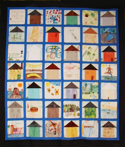Jan Cohodes' project
Jan writes:
"By day I teach the deaf in a local public elementary school. Several summers ago I taught a 5th grade deaf class. I decided that in addition to keeping up their reading and math skill, we would spend time learning some kind of recreational skills. Naturally, since I would rather sew than eat, I thought that sewing would be a good idea.
"That summer we did a pioneer unit. The kids learned about the westward migration of America and about quilting. The first project was a nine-patch pillow that the kids had to piece by hand. Some of them had never held an needle, but they all worked very hard and piced them will various levels of ability. I bought some of the fabric and used some of my stash. Then we cut the backing out of one of the fabrics they used and we sewed the front to the back on the machine. They stuffed them and finished them off by hand. Most of them chose to keep them at school and usually took them to the library corner of the room when they want ed to curl up and read. They were so proud of themselves.
"At first the girls thought that the boys shouldn't do this. But I told them that some day, the boys would be grown up and living on their own. Maybe they wouldn't make their own clothes, but they need to learn enough sewing to be able to mend their own clothes and sew on buttons. Sooo everybody sewed.
"While they were hand piecing their pillow tops, we also spent some time at the machine - learning how to thread it, put in the bobbin, etc. What they really wanted to do was SEW with the machine. They practiced "sewing" without thread on paper with rows of straight lines then with corners and then with a spiral pattern. Once they were comfortable with the speed and handling the machine, they were ready to tackle fabric.
"I thought the Rail Fence pattern would be easy for them - but would give a more complicated look when they were finished. They cut the fabric the traditional way, using templates, for a few of the blocks. They complained that they wanted it to go faster. but i explained that this was the way pioneer women and earlier quilters had to cut out the fabric. For the remaining blocks we measured out 2-1/2" strips and tore them cross grain. Then they sewed the strips together and cut the blocks from the strips.
"I had to get written parental permission for them to use the machine, stating all the 'dangers" of using the machine. Using a rotary cutter to cut the blocks was out of the question, but they used a quilters' rule and marked the blocks and cut them with a scissors. All but one parent gave permission. That child opted to do another hand pieced project.
They sewed the tops. While each child sewed, i sat right behind them to minimize the possibility of injury. The kids loved it and they all completed a mini-quilt about 24"x36". The summer ended before we could put the mini quilts together. But I sent each child home with batting and backing and written directions for completing their project. Several of the girls wanted to make their quilts bigger so I sent them home with more fabric and a note telling the family where I bought it. They were so proud of themselves and rightly so - they did a GREAT job. One of the girls continued sewing and told me that her granmother bought her and inexpensive machine to get her started. I still hear from the kids and they all remember the sewing summer.
"I do to - I had so much fun."
If you'd like to share your story on these pages, please email Heddi at qwc@thecraftstudio.com.
© Copyright 1996-2012 Heddi Craft

